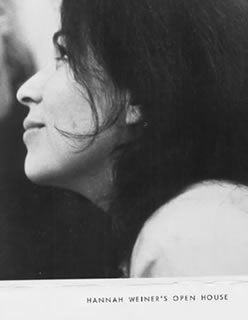Perhaps the most shocking revelation in Hannah Weiner’s Open House, out this past spring from Kenning Editions, comes in the very last sentence of Patrick F. Durgin’s excellent introduction. It’s not the fact of just how many of Weiner’s books are out of print, nor how lucid & unpsychotic Weiner’s pre-“clairvoyant” writing is, nor even how lucid & unpsychotic some of her later work is (Cf. “If Workshop,” a proposal it would seem from the late 1980s), not even how little actual space, just ten pages from 156 given to her work, that the excerpt Clairvoyant Journal, Weiner’s signature volume, takes up in this impeccable version of a selected works.
The real shocker is that Patrick F. Durgin never met Hannah Weiner, who’s been gone now for only ten years. This is a shocker because Durgin would appear to have become the best friend Weiner ever had. Durgin has done more than anyone to make her writing accessible, thus to enhance her reputation. Now with Hannah Weiner’s Open House, he gives us the big picture, the book that shows the overall arc of this remarkable poet’s entire career. It’s a wonderful collection, even tho (or perhaps because) it’s going to send many of its readers to AddAll or Abebooks.Com to find whatever remains available of the original texts.
In the past I’ve characterized Weiner as a militant & precise realist of a distinct reality, one conditioned by her schizophrenia. Nothing in HWOH makes me want to step back from that description, tho this volume does a far better job than any of her previous books in placing Weiner’s writing and its development into a larger framework, one that includes the downtown
One might have expected Weiner to have been closer, in fact, to the first round of the
Weiner was even slower to begin publishing, with her first book, Magritte Series appearing in 1970. Clairvoyant Journal, the volume that made Weiner famous (or at least notorious) with its claim to have had portions of the text transcribed from language Weiner saw on people’s foreheads, on walls, or simply hovering mid-air, at times in elaborate textures, such as dog fur, is published by Angel Hair in 1978. It’s only her second book – Weiner was already 50.
This is a problem as much of the performance art scene as it was a question of the difficulty women still had getting into print in the 1970s. Jackson Mac Low, Weiner’s friend in that scene who likewise later gravitated toward language poetry, didn’t publish his first big book, Stanzas for Iris Lezak, until he was 48. It was only his fourth book.
Happily, both writers are now acknowledged as the major poets they were, and with HWOH, we finally have a good first step toward presenting her work in print in the same kind of comprehensive & intelligent fashion that has so transformed Jack Spicer’s influence & reputation in the four decades since his death. Durgin has done an especially good job dealing with the typographical challenges presented by Weiner’s texts, which can included many an undotted i and uncrossed t, can slide down the page or over other type. He treats the page as Weiner did, as a compositional field, reproducing some texts directly from books where Weiner herself had an opportunity to approve the final setting, and setting others “with comparable but uniform typefaces.” It’s the antithesis of the disaster than
Patrick Durgin here has accomplished something major. It makes you realize just how much a poet like
¹ Paul Mariah, Lew Ellingham, Lori Chamberlain, John Granger, Steve Abbott, the editors of Acts, even Kevin Killian, just to name a few.






